しぶとい夏の暑さが残る9月下旬。社内向けにUL(ウルトラライト)ハイキング研修というのを行ってきたのでそのレポートを書こうと思う。
ULハイキング研修って何?と思われる方が多いと思うが、この研修はとあるアウトドアギアメーカーさんと関わりを持ったことをきっかけに行われた、1泊2日のハイキングを伴う体験型の研修だ。ULの精神でハイキングをすることは仕事においても普段の暮らしにも、よい気づきがあるはずだという仮説のもとで行われた。(これは神山ハイキングクラブでもテーマに掲げていることだ。)ULハイキングは、私の人生に大きな変化をもたらしてくれた。今度はそれを会社の皆へ向けて、少しでもエッセンスが伝わればという思いで、この企画をやらせてもらうことにした。
今回の研修に参加してくれたメンバーは以下の3名。皆、運動をしていた経験はあるがハイキングはほぼ初めてのようだった。
-
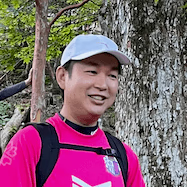
-
張(ちゃん)
モノサスのバックオフィス担当。結婚・子育てを機にキャリアとライフをトレードオフにしないための試行錯誤を重ねた経験とULハイキングとの親和性を感じて参加。
-
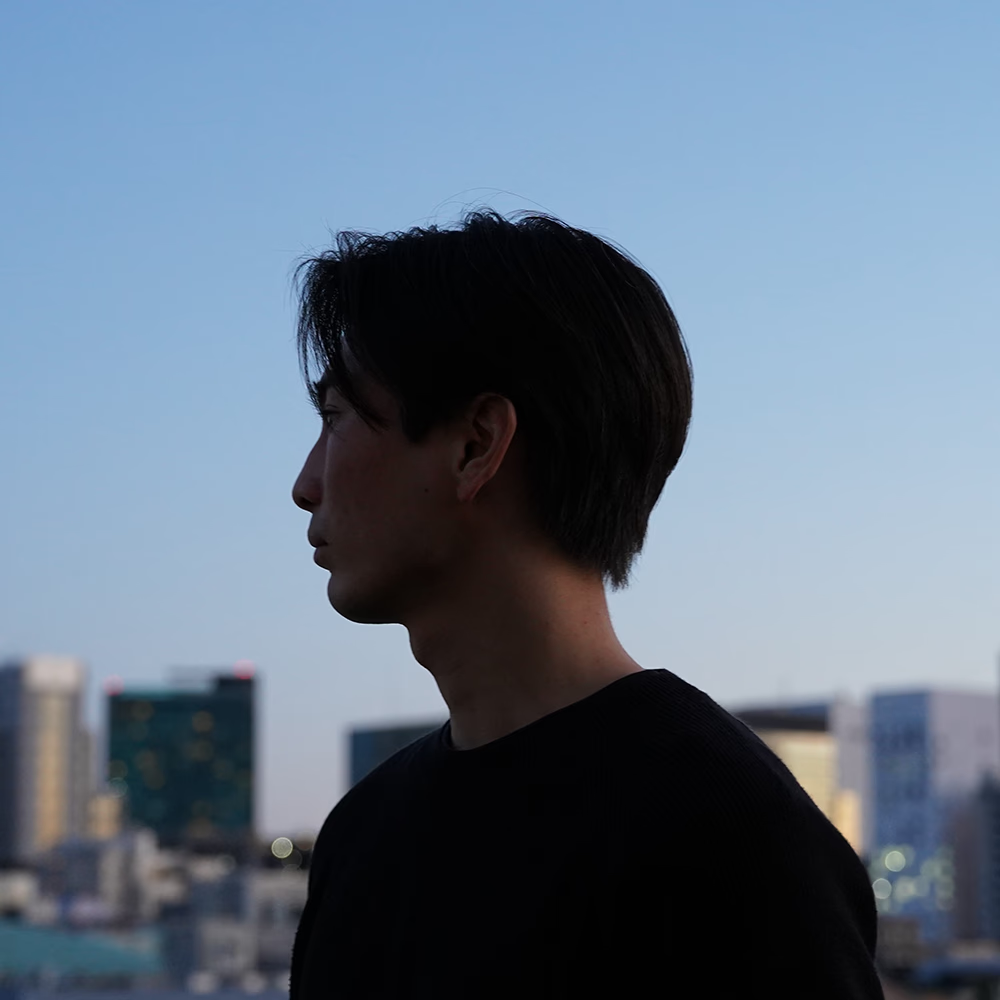
-
元木(もとき)
モノサスのバックオフィス担当。ミニマリスト。多くの物を所有せず、普段からなるべく少ない荷物で生活している。ULハイキングの概念に深く共感し、今回の研修への参加を決意した。
-
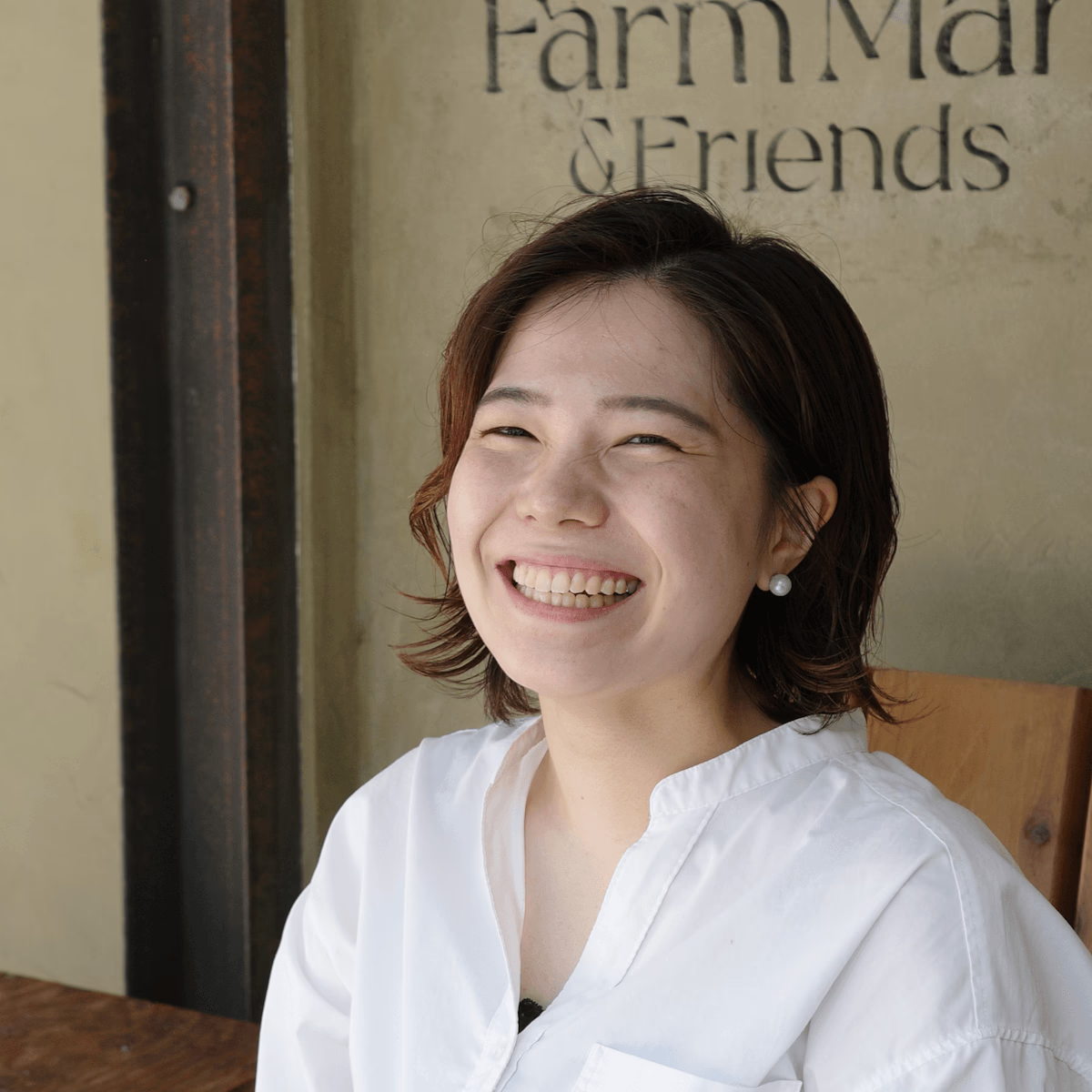
-
望月(もちづき)
モノサスのバックオフィス担当。1人旅にハマり始めてから日本各地を巡るフットワークの軽さを持ち備えているが、普段はULとはかけ離れるほどモノに囲まれた生活をしている。
座学
まずは代々木本社の会議室に集まり、ULについて学ぶ時間をつくった。ハイキング研修といえどいきなり山へ行くのではなく、まずは情報をインプットしてから準備をし、それを確かめるようにハイキングを行うのが良いと思ったからだ。ULハイキング研修がより良いものになるようにと、座学では大きく二つのことを伝えた。
一つは、ULとは何か?ということ。
そもそもULという言葉を知らない人は多いと思う。ユニクロのダウン?とかそのくらいだと思う。私もかつてはそうだった。座学で用いた資料から抜粋すると、ULとはこういうことだ。
もう一つは、なぜULハイキング研修を会社でやるのか?ということ。参加してくれた社員は、社外の友人にこの研修のことを話すと「なぜそんな研修を会社でやるの?」と不思議がられたそうだ。こちらも座学のための資料から抜粋してご説明しよう。
特に伝えたかったのは、軽くすることが目的ではないということ。軽くするのはあくまで手段であり、軽くした先にあるものの選び方や自分の考え方を見直し、そして自分の働き方、生き方を考えるためのヒントを得てほしい。これまで私がULハイキングを通じて感じたことを言葉にするのはとても難しく、どう伝わったのだろうかと不安だった。それでも、まずはこれで実践してみようということで座学を終えた。

座学の後、実際に使う道具を並べて重さをはかり、リストを作成した。
準備、移動
座学をしてから2週間ほどあけての実践編。舞台ははモノサス神山オフィスのある徳島県神山町の里山、雲早山。私が住む横浜からは電車と飛行機と車で約4時間の移動だ。早朝の電車へ乗り込み、羽田空港へ向かう。普段の出張よりもはるかに大荷物になってしまったザックのストラップを肩にめり込ませながら「荷物の重さは、不安の重さ」と豊嶋秀樹さんが言っていたのを思い出していた。皆を山へ連れて行くことの不安、研修として何か成果があげられるのかという不安が詰まっていたように思う。
徳島空港へ到着し空港から神山町へはレンタカーで移動。車中で、今回の企画を一緒に設計していく張さんと最終的にこの研修がどういうものになると良いかといった話をした。
研修で考えて欲しい項目を設けること、ある程度自由にしてもらいながらも考えて欲しい枠だけお伝えすること。今回の研修では、普段の仕事や生活に何らかのヒントを持って帰って欲しいねらいがあるので、それをあらかじめお伝えすることにした。
後からわかることになったのだがその設定が研修のキモであった。(振り返りへつづく)
ハイキングは目的やスケジュール、交通周りの手配なども含め、決めなきゃいけないことがたくさんあるが、決めすぎない方が良いこともある。それは私が遊びで行くハイキングの計画も同じで、その塩梅がとても大事なのだ。
日程とコースと立ち寄る場所、それから予定通りにならない場合のことも考える。天候が崩れたり、参加する人の当日の様子、道路の混雑状況なんかも含め、ハイキングは予定通りにならないことがよくある(途中で予定変更して下山するルートのことをエスケープルートという言い方をする。あらかじめエスケープルートは頭に入れておく必要がある)
準備をすることと、準備をしすぎないこと。そして、あらゆることを想定しておくこと。私がハイキングに感じている魅力は、準備段階にそのほとんどが含まれていると思う。
移動後、まずは神山オフィスを訪問。神山オフィス勤務のメンバーとの再会を喜び、初めましての方々とも挨拶を交わした。それから各々で通常業務の時間をとり、夕方から翌日の道具選びとパッキングを始めた。翌日からの1泊2日のハイキングに持っていく荷物は何があるか?それぞれ何に使うものか?を棚卸しして考える時間となった。
参加者は皆自分のギア(山道具)をほとんど持っていなかったので、バックパックからテント、シュラフ(寝袋)、マット、ガスやアルコールストーブなど借りてきたものをばーっと畳に並べてみた。あらかたの特徴や使用方法など説明をして、自分のイメージに合うものを選んでもらった。テント一つとっても、ワンポールシェルター、ビビィ、自立式テント、などいくつかの種類が揃っていた。建てやすさ、軽さ、寝心地、など実際に使ってみる前にその道具の特性をまずは頭で理解する。その後、山で実際に張ってみて、寝てみることで確かな知識となっていく。その繰り返しが自分らしいハイキングとなっていくのだと思う。これは仕事に対しても同じことが言えるだろう。
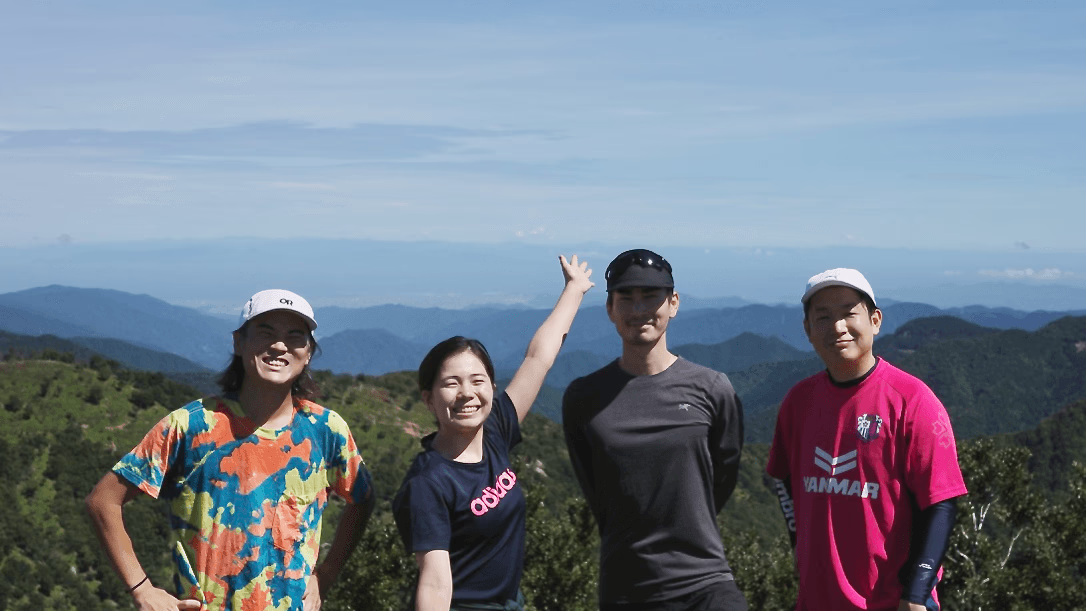
道具が決まったらパッキング。実際にバックパックに荷物を入れていく。
この時に注意すべきは入れる順番と入れ方だ。すぐに使わない且つ軽いものから順に入れていく。必要な時に必要なものをサッと取り出せるようにするためと、重たいものはなるべく上に入れることにより重心が安定し、歩きやすくなるためだ。
また、なるべく密度が高くなるように、モノによってはサックから出して詰め込むとか、水や食料を入れる場所を残しておくとか、アドバイスをしながら各々が荷物を詰め込んでいった。こんなに入るかな?とか、この道具はどのポケットに入れておこう?とか、明日のハイキングでの答え合わせが楽しみになる時間だ。

吊るしのはかりで最終的なベースウエイト(水や燃料を差し引いた荷物の総重量)を量る。皆、3.8kg〜4.5kgとULな重さだったが、私は7kgとかなりヘビィな荷物になった。
パッキング後に夕食。神山勤務のメンバーも集まり、お好み焼きを作り大いに盛り上がった。こうして普段顔を合わせることのないメンバーが集まって食事をともにできるのも、オフサイトで行う研修の魅力だ。
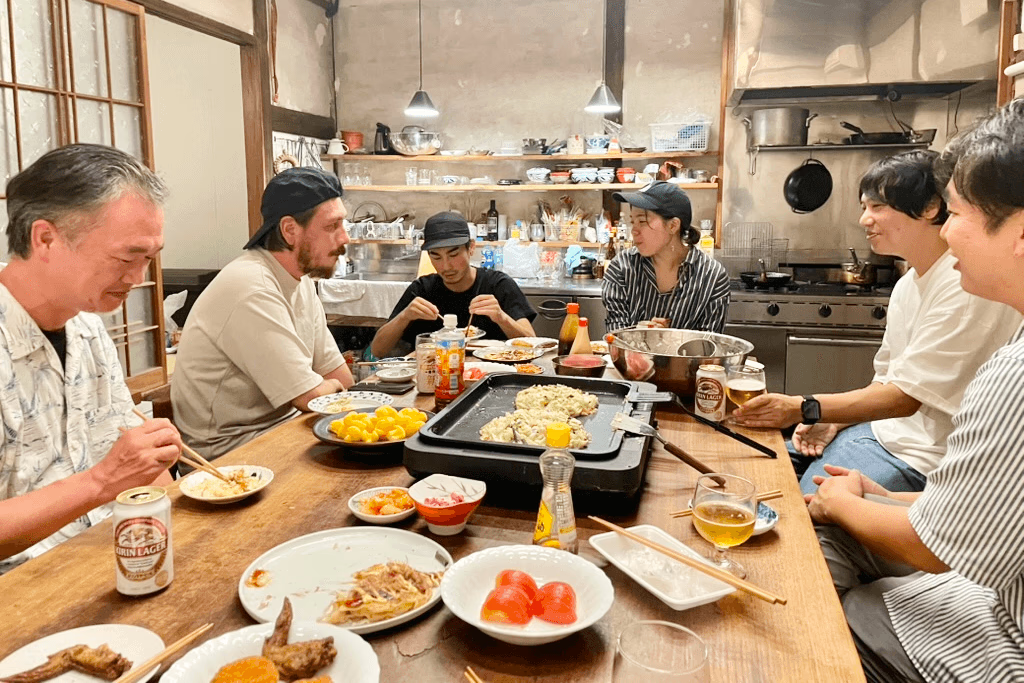
テーブルにホットプレートを出して、お好み焼きを焼きながら日々のことを話した。
この日は神山への移動とパッキング、神山に住むメンバーとの交流で1日を終えた。山へ入る前に、神山に住む人たちと交流すると山で行う研修がより深いものになるように思う。翌日の夜に山の上から見た町の灯りは、こういった日常の何気ない時間を思い出すこととなった。
ハイキング、山での宿泊
ハイキング初日。朝5時過ぎからゾロゾロと起き出して、眠い目を擦りながら支度をした。前日にあらかた準備を済ませていたおかげですんなりと出発することができた。コンビニに集合し、エネルギーになる朝食と行動中の水、食料を買う。パンやおにぎり、コーヒーなど、その場で食べたり行動中に食べるようにザックへ入れたり。ここで最後の準備をする。
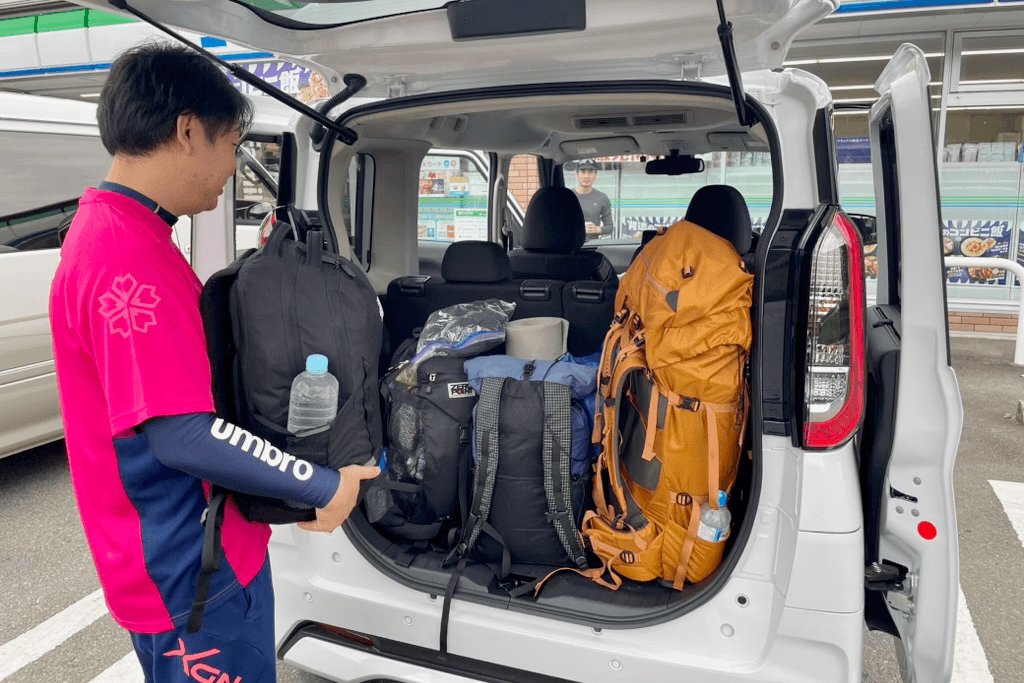
「なんとか入った!」と安堵する張さん。この日の夜、食料が中で弾けていることに気づく。
山の麓へ移動し、スマホ画面で大まかなルートと時間配分の共有をしたらハイキング開始。今回のハイキングコースは片道約4時間。途中で休憩を取りながらゆっくり歩いて山頂を目指す。山頂を通り過ぎたところでテント場を探し、テント設営、辺りを散策、夕食、就寝。という流れを予定していた。
いきなり下るコースに驚きの声が上がったり、入り口の沢で早速顔を洗ったり、皆がワクワクした表情で歩き始めた。
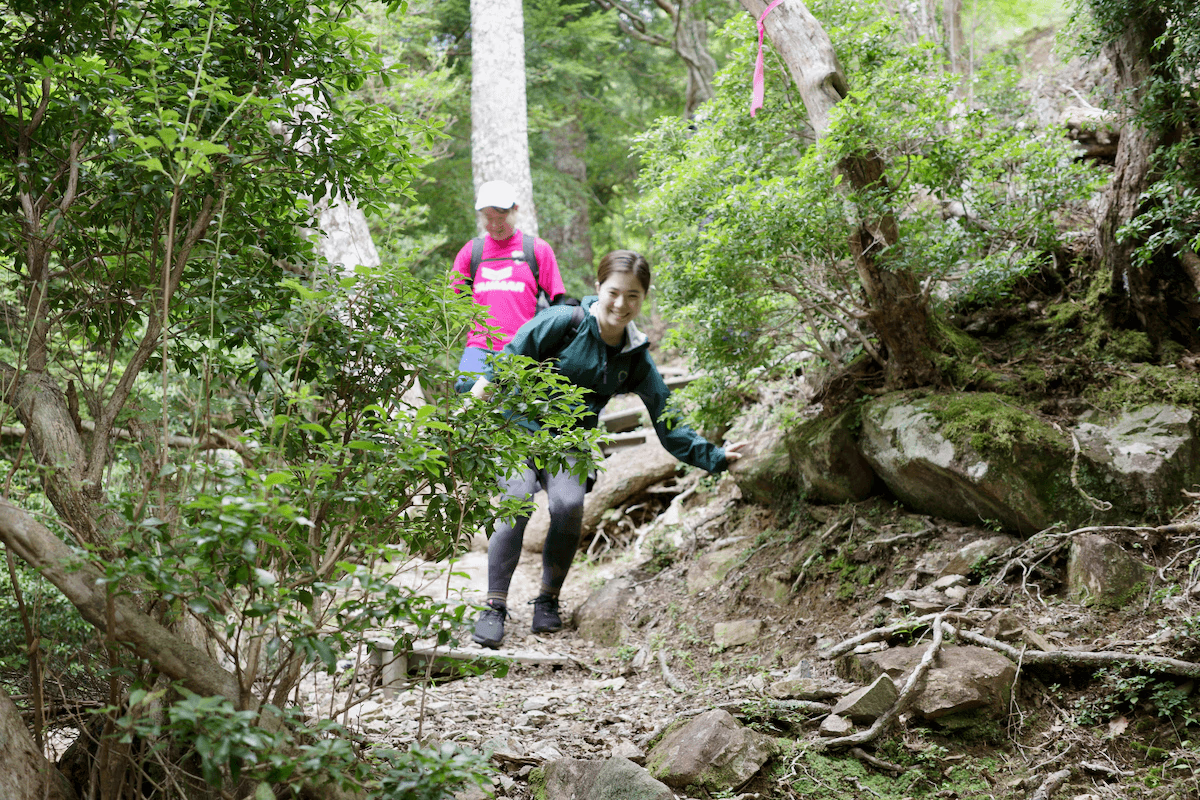
1時間ほど歩くと稜線へ出た。稜線とは、山の尾根のことで、この線をたどると山から山への縦走となる。南西の方角から吹き上げる風が吹き出した汗を冷やし、少し寒さを感じる。サイドポケットにしまっていたウインドシェルを取り出し、温度を調整した。
途中、方角を調べて東京はどっちだろうと話をしたり、携行した道具のレビューをしあったりもした。
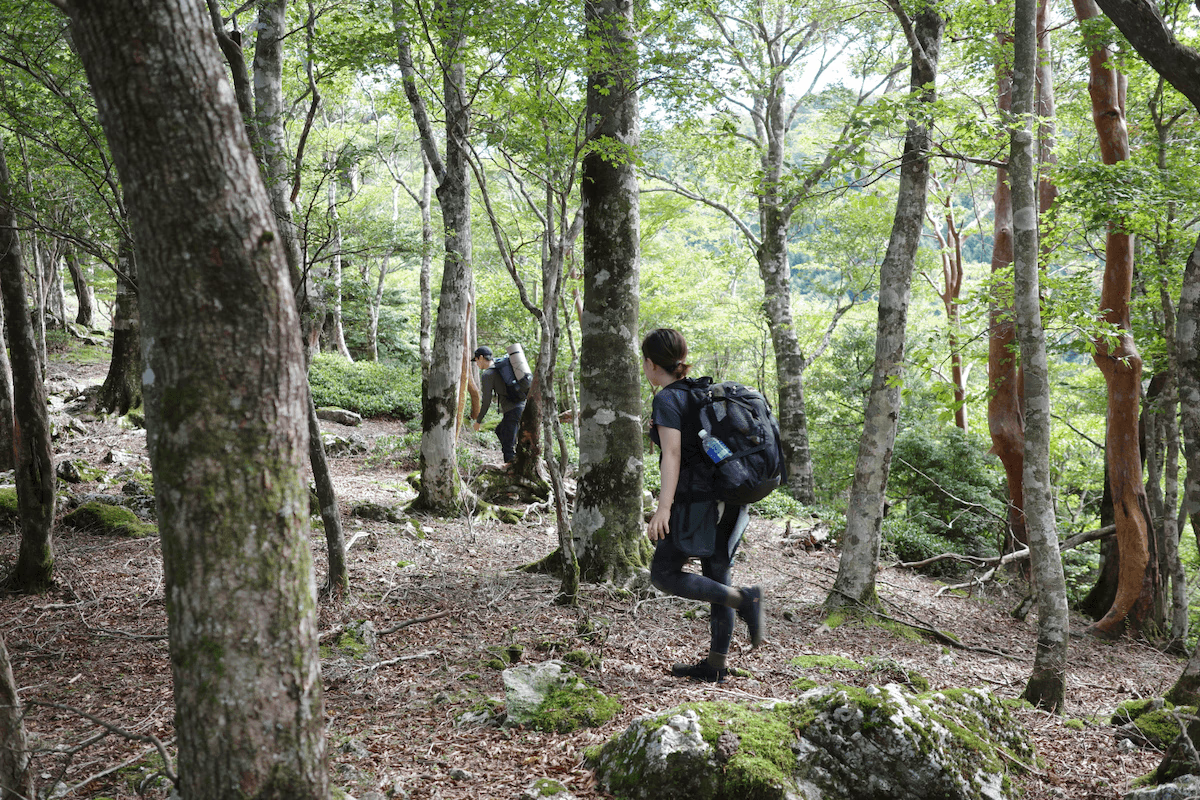
途中、方角を調べて東京はどっちだろうと話をしたり、携行した道具のレビューをしあったりもした。
眺望が良い開けた道に出て、ランチをとることにした。
おにぎり、パン、惣菜、コーヒー。思い思いのものを広げてそれぞれに楽しんだ。かまパン(モノサス関連会社、フードハブ・プロジェクトが運営する神山町にあるパン屋)のパンを山で食べられるなんて最高!という張さんや、ドリップバッグでコーヒーを淹れようとして、湯沸かし用とサーバー用に、コップが2つ必要なことにそこで初めて気付いた元木さん。
そんな様子を見ていて、話してみるのと実際にやってみるのはどこか別の回路が働いているのだなとじわじわ実感していた。


ランチをとったあと1時間程度歩くと、辺りの植物の背が低くなってきた。近くの山々もはっきり見え、頂上が近づいてきていることを感じた。いよいよ雲早山の頂上だ。最後の急登を登り切って登頂した時は、何か成し遂げたような満足感を皆の笑顔から感じた。
頂上から尾根を指差しながら、どこのあたりに泊まろうかとかを話をした。すぐ近くに見えるポイントが、実際歩いてみたら30分以上は離れていたりする。建物がニョキニョキはえている街の景色と、遮るものが少ない山の上では距離感が違うんだと感じた。


そこからはテント場を探して歩いた。登山コースからは離れた場所、なるべく平らでひらけている、という条件で皆で周りを見ながら歩いた。
良さそうな場所を見つけ、荷物を下ろしてまずはテントを張ることに。時刻は14時くらい。普段、平日のこの時間はまだまだ仕事をこなしている時間帯だろう。しかし山ではこのくらいの明るいうちにテントを立てるのが好ましい。
それぞれどのあたりにテントを張るかを、ガサガサと落ち葉を踏みながら探した。ここはふわふわしているとか、平らだけど狭いとか、寝転がってみたりしてそれぞれの「家」となる場所を探した。
場所が決まり、特徴の違うテントを一つずつ張っていった。前日に少し雨が降ったのもあってか地面は柔らかく、ペグを差し込むのは容易だった。テンションの掛け方、紐の結び方、一つ一つを手触りで実感しながら設営を進めた。


テントが完成しそれぞれのテントを見渡すと、そこは一つの町になったような気がした。テントのちょうど中心の平らな場所をさして、ここが集会所だね、などと話をしながら早くも夜ご飯が待ち遠しくなる。それから一休みして、辺りを散策することにした。雲早山の頂上から見えた、少しひらけた場所がこの先にあったはずだ。
テント場に荷物をデポ(荷物の一部または全部を途中に置いていくこと)していったので、羽が生えたように身体は軽かった。特に荷物の多かった私はその身軽さにウキウキした。
途中で、抹茶色に苔がびっしり敷き詰められた道があり、まるで高級な絨毯のようだった。そういうことに気が付いたのも荷物が軽くなったからなのかもしれない。
ひらけた場所に着くと青い空と秋らしいすじ雲が広がっていて、その日歩いた道を思い出しながら爽快感を感じた。良い季節に山に来れたなと嬉しくなった。
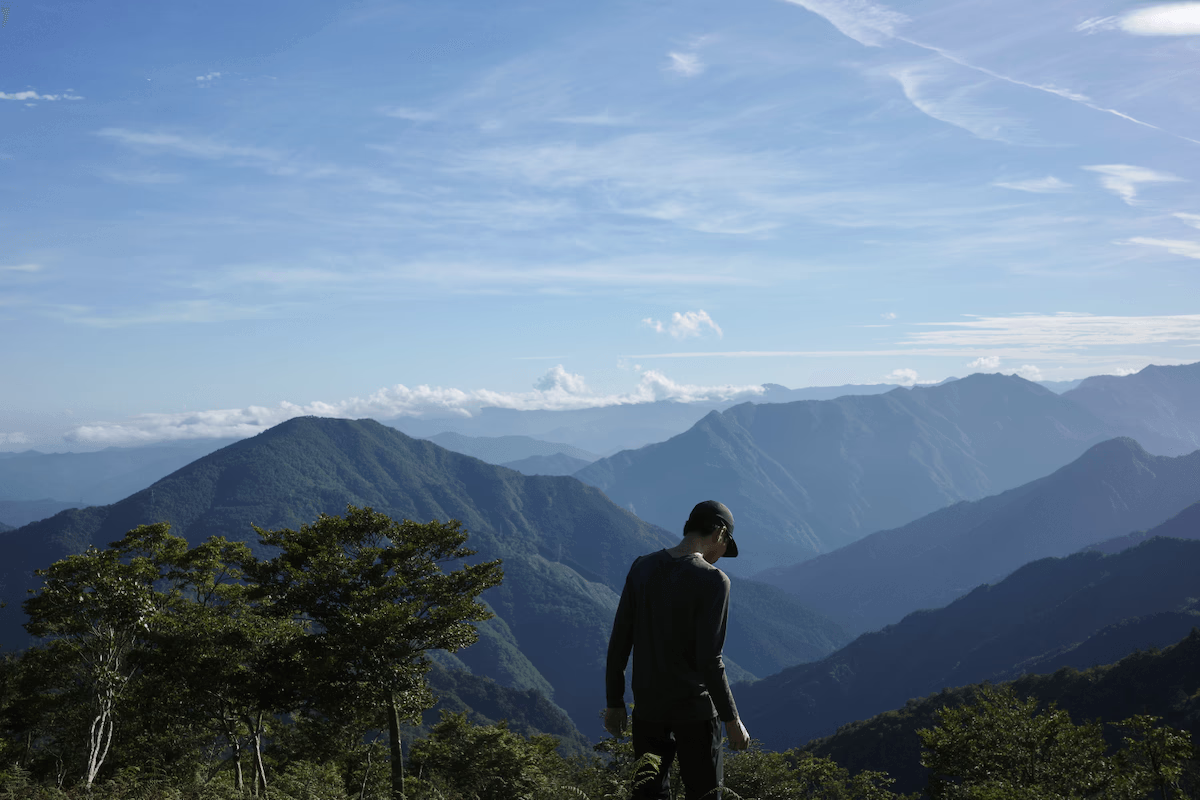
テント場へ戻り、夕食を準備し始めた。小さい焚き火台を持ってきていたので近くの木を拾い火をつけた。木が湿気ていてなかなか火がつかなかったが、細くて小さい枝から徐々に太い枝へと燃料を変えていき、やがて調理ができるくらいまでの火へ育った。持ってきたパンや缶詰を温めたり、湯を沸かしてドライフードを作ったり、それぞれが計画してきたことを答え合わせするように調理をし、またそれを交換しあった。


私が用意した夕食で一番美味しかったのは、炙った米粉バケットだった。
焚き火を囲みながら、だんだんと夜が深くなっていった。暗くなると周りは静かで、目の前の焚き火がゆらゆらと揺れて、ただそれを眺めたり吹く風の音に耳を傾けたりした。私たち以外に誰もいない静けさの中で贅沢な時間を過ごした。
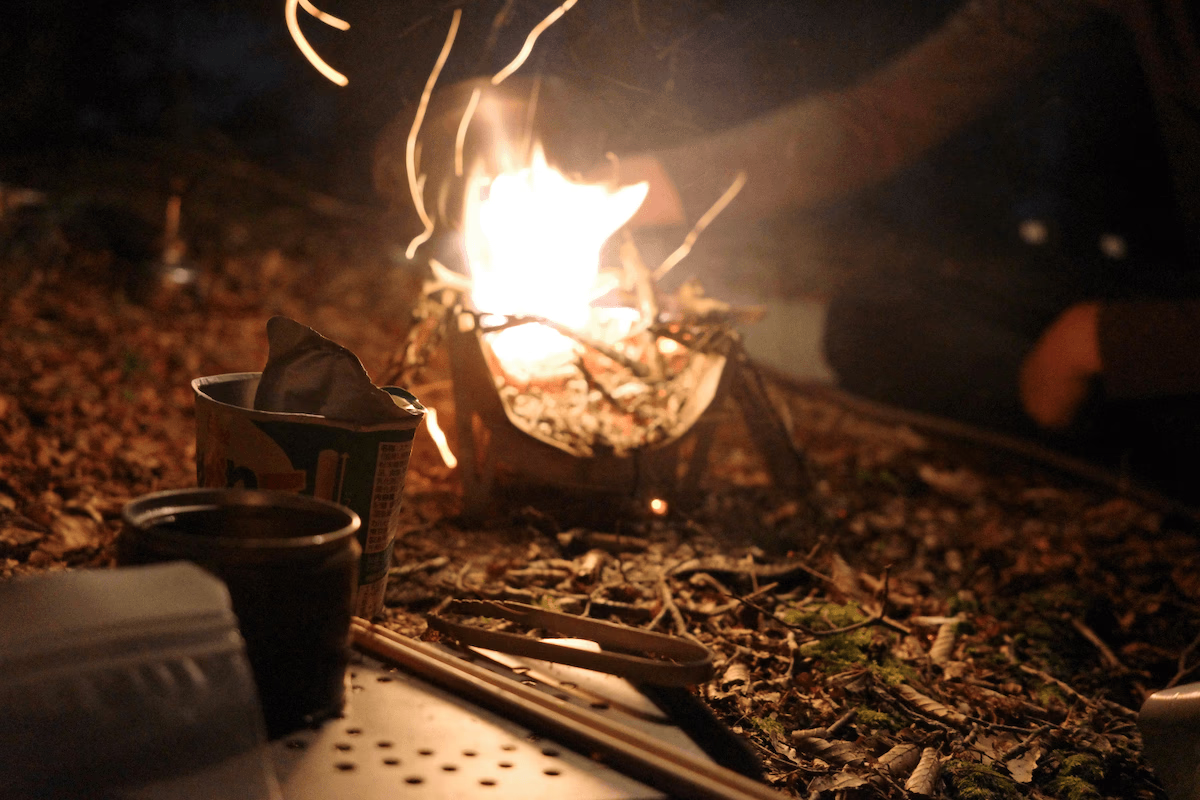
一通り食事をしたあと、暗くなった夜道を少し歩いてみることにした。日中の明るい時と暗闇では、全く別の場所かのように道はわかりづらく、少し不安な気持ちになった。それでもヘッドライトのあかりを頼りにゆっくりと歩いていくと、だんだん目が慣れてきて、月明かりがとても明るいことに気がついた。
ふと、数時間前に同じ道を散策したときにここは苔が緑の絨毯みたいだねと話していたことを思い出した。何かを感じてそれを言葉にして外に出すと、意外なところでそれが生き返ることがある。月明かりに照らされてぼんやり光る緑の絨毯を発見し、ほっと安心して道を歩くことができた。
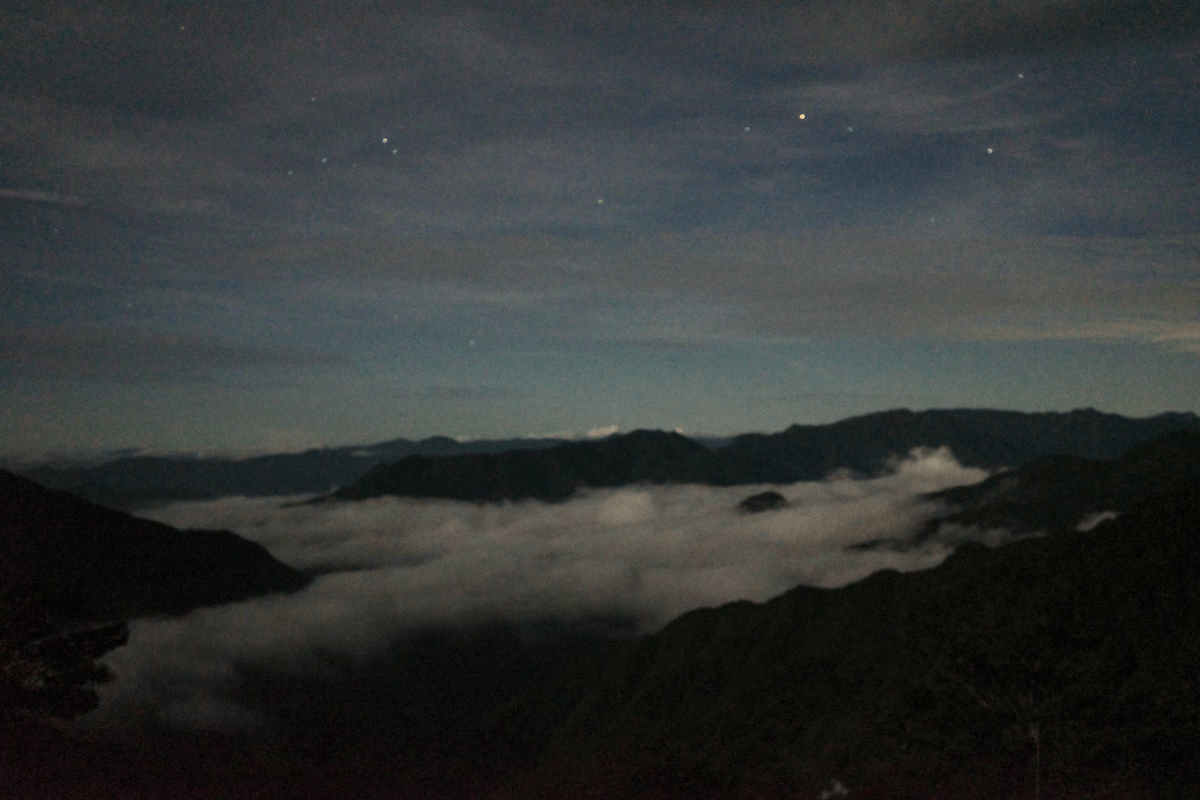
ひらけた場所へ出ると、向こう側の山とこちら側との間に雲海が広がっていた。飛行機から見えるそれとは違い、この距離で見る景色は壮大だった。
ハイキング1日目はこれで終了。自分のテントへ戻り、マットと落ち葉の柔らかさに沈み込むようにぐっすり眠れた。
翌朝、下山
翌朝は5時半ごろに目が覚めた。朝日が登ってきていて、あたりは夕焼けのように鮮やかなオレンジに染まっていた。空気がひんやりしていて気持ちが良いので、眺望の良い場所まで少し散歩した。昨夜広がっていた雲海は奥の方にほんの少しだけ残っていた。テント場に戻りコーヒーを入れて、軽く朝食をとった。山で朝日を浴びながら飲むコーヒーとパンは格別だ。


二日目のハイキングはほぼ下りだけなので、比較的歩きやすいコースだったように思う。皆、前日のアップダウンで多少山歩きに慣れてきていたし、互いに声を掛け合ったりと、一体感も生まれてきている気がした。
倒木を避けるときや棘のある枝が伸びている時、草木をかき分けて進むとき、後に続く人を思い声を掛ける。大袈裟だけど山ではそういった声かけが誰かの命を救うことになる。
普段からチームで仕事をすることが多い私たちは、前方で何が起きているか、後方を歩く人は何を思っているか、といったことに想像を膨らませて取り組むことが、ゴールへ無事に辿り着くために大事なことなんだと山を歩いていても感じられた。


山頂付近から2時間ほど歩くと、登山口付近まで降りてこれた。そこには沢があり、汗でどろどろになった身体に水をバシャバシャかけた。携行していた水が直前でなくなってしまった元木さんは、まるでオアシスを見つけたかのように水に飛びついてゴクゴク飲んでいた。
沢から車を停めた場所までは「スーパー林道」というじゃり道をゆっくり歩いた。林道から、私たちが昨日今日歩いてきた稜線を見上げた。あそこを歩いてきたんだね。そう話すとなんだか山の景色は昨日と少し違うものに見えた。ハイキングが終わってしまうことへ寂しさを感じながら、あっという間に駐車場に到着。舗装された道路は、大きな丸太を跨いだり、グラグラする岩を踏んだりする山道と違ってとても歩きやすかった。
どさっとおろした荷物とともに車へ乗り込み、町へ戻った。やはり疲れていたのか運転手の私以外は皆、車に揺られてうとうとしていたようだった。とにかく無事に降りて来られて安心した。
町へ戻り神山温泉で汗を流し、かま屋でランチ。山で過ごした翌日の美味しい食事は身に染みるように美味しかった。ああ、町に帰ってきたな。と、ここでもまた一安心したのだった。
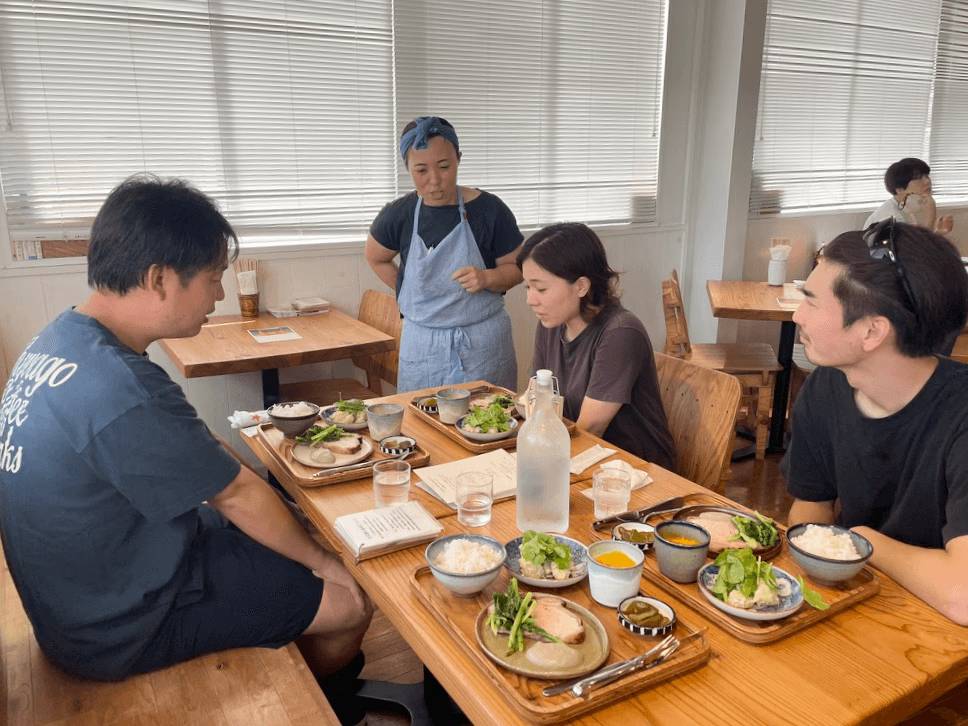
かま屋の料理長、もぐさんのメニュー紹介。もぐさんの料理は説明まで美味しい。
振り返り
ランチのあとはオフィスへ移動して振り返りの時間をとった。まずはそれぞれ感じたことを書いていくワークの時間として、そのあと発表をした。振り返る項目は以下の通り。
1.準備・計画段階(座学、買い出し、パッキング)
2.行動時(山を歩いている間)
3.停滞時(登山合間の休憩、テント場、夕食・朝食)
4.下山後(朝~水辺・林道から車まで)
◆振り返りの観点
・ULハイキングの体験を通じて感じたこと
・仕事や生活に適応できること
・上記を踏まえ、まず何かできることがあるか
1〜4それぞれの場面で、どんなことを感じ、それらをどう適応していくかを考え話し合った。そこではこんな意見が交わされた。一部を抜粋して紹介する。
1.準備・計画段階(座学、買い出し、パッキング)
・ULハイキングとしての体験
ハイキングに必要だと思ったモノをまず自分で考えてリストアップしました。その総重量を計測していくと、ULハイキングの定義する重量をオーバーしてしまいました。
そこから、基準値となる重さを踏まえて、「本当に必要なモノは何か」「1つのモノで2つ以上の役割を果たせるようにできないか」を考え、モノをそぎ落とす作業や、「必要なモノだとしても別のものに置き換えて軽くするすることはできないか」と考え、置き換えを実施する中で軽くしていきました。
・仕事や生活に適応するとしたときの気づき
普段の生活でも、あれもこれもとついカバンに詰め込んで重くなったり、本当に必要なものかを吟味せずに衝動買いしていつの間にかモノにあふれた生活環境になってしまっている日常と向き合いました。
本当に自分が持てる重量(自身の理想とする動きやすさ・快適さ)を理解してこそ、何を持つか、何を手放すかを選択することができるということに気づいた。何があれば満たされるのか、どれくらい必要なのかを理解して生活設計していきたいと思う。
2.活動時(山を歩いている間)
・ULハイキングとしての体験
慣れない山登りだったので不安定な足元に集中する場面が多かったですね。他の皆さんが周辺の景色を楽しんでいる時に一緒に楽しむ余裕がない時はもったいないことしてるな、と思ったのですが、足元をずっとみていても歩いている場所によって、落ち葉の色や種類が違うな、土の感触が少し変わったな、と足から伝わる感覚に敏感になっている自分に気づきました。あと、自然の中にいると開放的な気分になるからか、みなさんと普段聞いたことないことを聞けたり、話したりする時間も多かったように感じます。
その状況を改めて捉え直したときに、前提として自分の背負っている荷物(重さ)が山登りにおいて大きな懸念要素にはなっていなかったんだなと、そこで初めて気づきました。
・仕事や生活に適応するとしたときの気づき
外から無意識に入ってくる情報や、自分の脳内をぐるぐるめぐる考え事など日々いろんなものを抱えながらつい過ごしてしまいがちですが、持っているものが軽くなることで心に余裕が生まれるので、一歩引いて物事を捉えたり、本当に集中したいところへ意識を向けたりすることができると感じました。
3.停滞時(登山合間の休憩、テント場、夕食・朝食)
・ULハイキングとしての体験
登山合間の休憩時は、ザックが軽くて降ろすことが容易だから、さっと休憩できるところがいいなと思いました。登山を再開する時は、さっと歩き出せるところも。ザックを降ろして、岩や倒木、地面に腰掛けて、周りの景色を眺めることに集中していると、山々の大きさを感じたり、緑豊かな木々の美しさを感じたりすることができて、ULハイキングの真髄である「自然と一体になること」ってこういうことなのだと思いました。心が洗われるような、とても心地良い時間でした。もしザックが重かったとしたら、周りの景色に意識を向ける余裕もなかったのだろうと思いました。
テント場に着いて、眞鍋さんからお借りしたテントを設営した時はこう思いました。あんなに軽くてコンパクトだったものが、想像以上に安心して寝れそうなテントに早変わりして、ULハイキング用のギアの作りこみってすごいなと。案の定、安心してぐっすり眠れました。
夕食時、水が足りないことに気づきました。どうりでバックパックが軽すぎる訳だと。なんでもかんでも軽くすればいいという訳ではないのだと気づかされました。私の楽観的な性格が裏目に出てしまったなと省みることができました。
夜に暗闇の山の中で焚火を囲みながら、みんなと仕事について語り合ったり、たわいもない話をしたりして過ごした夜は楽しかったです。テーブルがあったわけでもなく、ごちそうがあったわけでもなく、私には水すらなかったものの、心は満たされていました。大層な物がなくたって、同じ目的をもって共に行動した仲間がいるだけで、楽しい時間を過ごすことはできるものなのだと思いました。
以上の体験を通して、頭では理解していた「足るを知る」ということを体で理解することができました。また、足るを知ったことによって生まれた余力で、足らないを知ることができました。
・仕事や生活に適応するとしたときの気づき
問題を解決したい時や物事を改善したい時、足らないものを補おうとしてその埋まらないギャップに苦しむことがありますが、実は足るもので十分だと考えることは、仕事や生活に適応することができる考え方であると気づきました。また、その足る状態であるからこそ、本当に足らないものがはっきりとわかるのではないかと思いました。
4.下山時(朝~水辺・林道から車まで)
・ULハイキングとしての体験
ハイキングも終盤に差し迫ってくると、水や食料も消費しているので荷物も軽くなってきたことで視界が開ける体験をしたことが印象的でした。荷物が重いとどうしても前傾姿勢になり、足元を見がちでした。結果、登山中に目線の高さにある枝や葉に気づかずぶつかってしまうこともありました。荷物が軽くなることで目線が上がり視界が開けることで、先を見通せたり周囲を気遣う余裕も生まれました。
・仕事や生活に適応するとしたときの気づき
仕事や生活で息詰まるときは、足元しか見れておらず視界が狭くなっていたりしがちです。背負っている荷物を軽くする(負荷になっているものを減らす)ことで自然と視界が広がることは、仕事や生活に適応できることだと学びました。気合ではなく、「物理的に」「仕組みとして」負荷を減らす機会を設けることの必要性を体感しました。
振り返り会は大いに盛り上がり、当初予定していた時間をオーバーし2時間以上行われた。それでも全てを話しきれず、空港へ移動する車の中でも会話は続いた。それだけ感じたことが山ほどあるんだなと、私は嬉しくなった。

この研修を経て得られたものが参加してくれた皆の中でどう育っていくかはわからないが、いつかより良い仕事や暮らし、人生に繋がっていってくれたら良いなと思う。やはり私たちの身の回りには、やってみないとわからないことだらけで、不安は行動を起こしてみて初めて形を変える。この研修を企画した私自身もそれを感じられる良い時間となった。
家に帰ってきて荷物を解くと、香ばしい焚き火の匂いを感じた。今回の研修は初めての試みだったが、今後初級編に続く中級編、上級編、というように続けていけたらまた違った反応があるかもしれない。これからもこの取り組みは続けていきたいと思う。
最後に、山にいる2日間、ほぼオフラインになってしまったがそれでも送り出してくれた家族と同僚のみなさん、迎えてくれた神山のメンバー、そして参加してくれた3人のメンバーに、感謝の気持ちを伝えたい。ありがとうございました。
